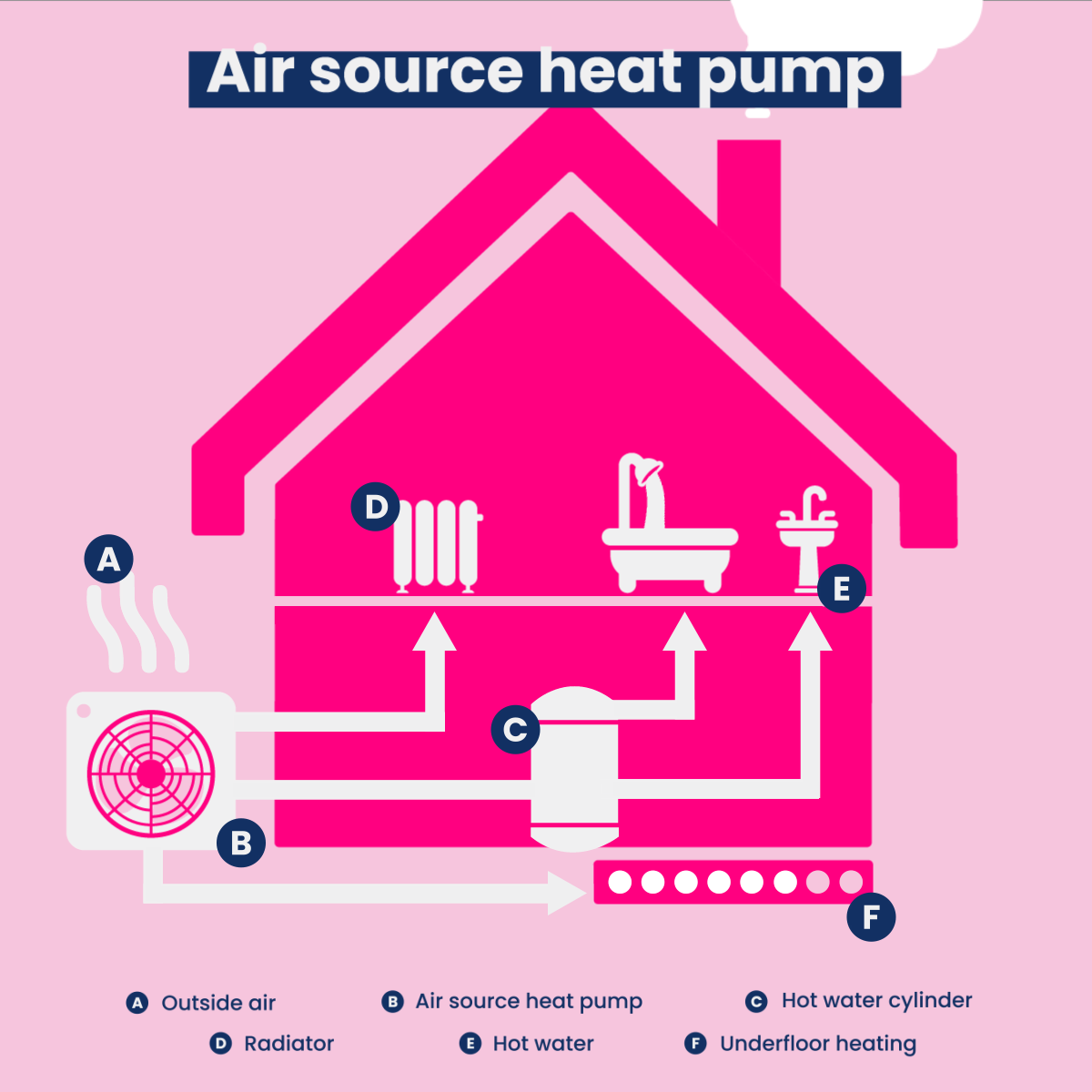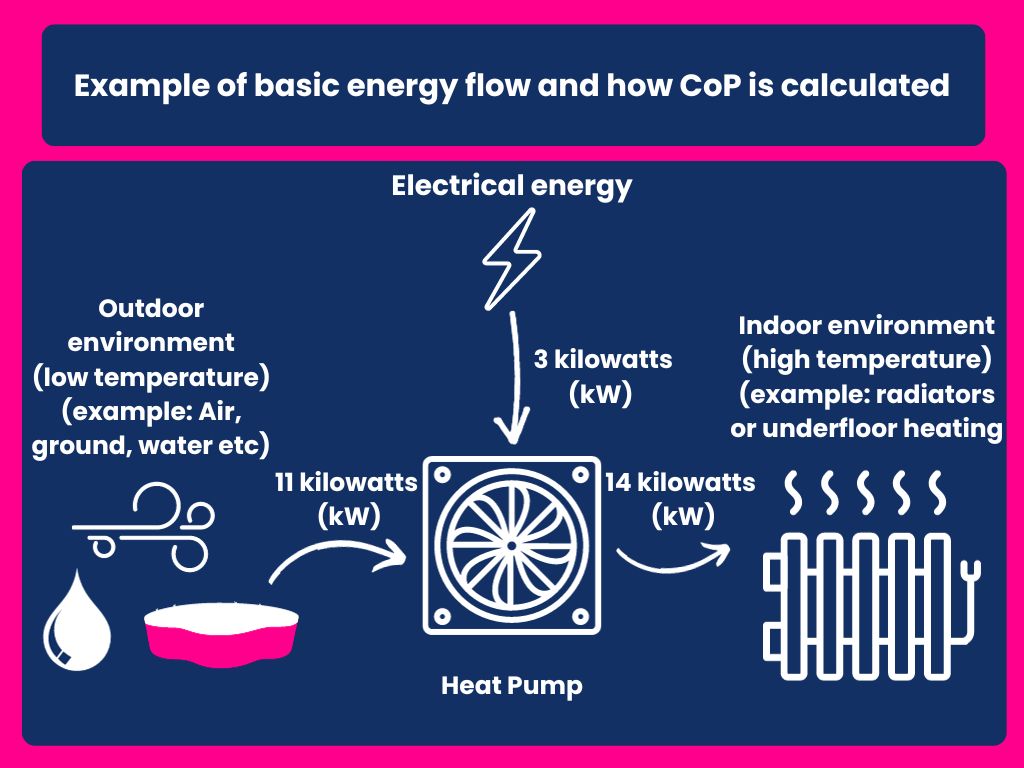When it comes to air source heat pumps, it’s important that you know all the ins and out so that you have all the information available to you before you commit to installing one.
So, that’s what we’ve done in this guide. We’re here to help you understand the air source heat pump and the way it works. Let’s jump in!
Table of contents
- So, what is an air source heat pump and how does it work?
- Is an air source heat pump energy efficient?
So, what is an air source heat pump and how does it work?
This is the question on many minds when they hear air source heat pump. Did you know that it’s also known as an air-to-water source heat pump? Quite the mouthful if you ask us.
Nevertheless, a heat pump is a fantastic heating solution. It’s used as a product to transfer heat from the air outside a building and turn it into water. This then heats your rooms through radiators or underfloor heating. It’s also worth noting it can heat water stored in a hot water cylinder. Very useful for hot taps, showers and baths.
How does an air source heat pump work? (the in-depth explanation)
So, we know the short breakdown, which is:
Heat is absorbed from the air and turned into a fluid. The fluid passes through a heat exchanger, moving into the heat pump. The heat pump raises the temperature and then transfers the heat to water.
What about the big technical part? Well, here we go.
Thermal energy (heat) is all around us, contained within everything. It will flow naturally from warmer places to colder places. So, why does this matter?
Well, when we want to heat spaces in a home during colder temperatures, we need that heat to flow the other way. That means from the cold place to the warmer place. Why is this? Well, the air source heat pump will do the work for you by heating up that cold air (and any other existing heat energy thriving in low temperatures) before sending it through your home heating systems to warm up the property. With us so far?
So, when a gas pressure increases, the temperature will also increase. It’s the same when the gas pressure decreases, the temperature does the same. This is the focal point for the workings of a heat pump. If you’re struggling to visualise this, we’ve provided a diagram to help you below.

What gas is in a heat pump?
The gas we refer to is called a ‘refrigerant’. Notice ‘fridge’ in the middle of that word? Well, that’s because it works like a typical fridge – just inside out! Since we want to heat up the interior of the property instead of cool it down.
This refrigerant is compressed by the heat pump using electricity. When this happens, the pressure and temperature increase.
The heat exchanger is what transfers this refrigerant heat through the home. As this happens, the refrigerant will cool down slightly, allowing it to expand to cool even more. Now that it’s cold enough, it should absorb more heat from the outside and start the process from the beginning.
Meanwhile, heat is sent to the heat exchanger. This is then used to heat your home. Although this is normally done via a central heating system, other options can be incorporated that use warm air via one of the following:
- Air-to-air heat pump(s)
- Exhaust air heat pump(s)
Is an air source heat pump energy efficient?
Air source heat pumps are incredibly efficient! Primarily because they require less electricity to produce that much-loved heat we need in colder temperatures. In fact, the government has set up a boiler upgrade scheme for those in need of one when said heat pump meets specific standards.
Indeed, the amount of heat they produce for every unit of electricity used has a special name – Coefficient of Performance (CoP for short). Here’s a little example to help you out.
Say you have an electrical energy input of 3 kilowatts (kW). If you have an 11 kilowatt (kW) energy input from the outdoor environment (low temperature), add that 3 kW of energy to the 11 kW input. This will have a total output of 14 kilowatts of energy for the indoor environment (high temperature).

Essentially, the heat pump system will scoop up any outdoor energy not obtained through electrical sources. This could be air, ground or water depending on the type of pump – in this case, air.
Now, for the CoP, you’ll divide the heat output kW by the electrical input, like so:
14kW divided by 4kW = 3.5 kW
Now, this total won’t be the same throughout the year. Although heat pumps are provided with published datasheets telling you a measured CoP, this will only be from a single test performed under particular test conditions at one point in time.
Is a CoP a reliable measurement for the annual heat pump usage?
Since temperatures fluctuate throughout the year, the CoP is not always something to take as gospel when understanding its potential running costs. Especially when ‘real world’ efficiency conditions are not in mind since the tests are not over a year.
For a thorough idea of what your heat pump may be producing, look out for a SCoP (the Seasonal version of a CoP) or an SPF (Seasonal Performance Factor). This focuses on the heat pump’s performance throughout the year, not just at one point in time. In particular, the SPF must be calculated based on the installer’s system design for the home and by said installer. The result should give an idea of how it will perform in the average temperatures in the area, including things like the size of the radiators.
The installer must make you aware of the SPF calculation before they do any work. It will help you learn what your system’s running costs and efficiency will likely be.
Now you know how an air source heat pump works, head over to our buyer’s guide to find the right one for your thermal requirements. We also have plenty of other advice surrounding heating needs and more, so don’t wait to check it out.





